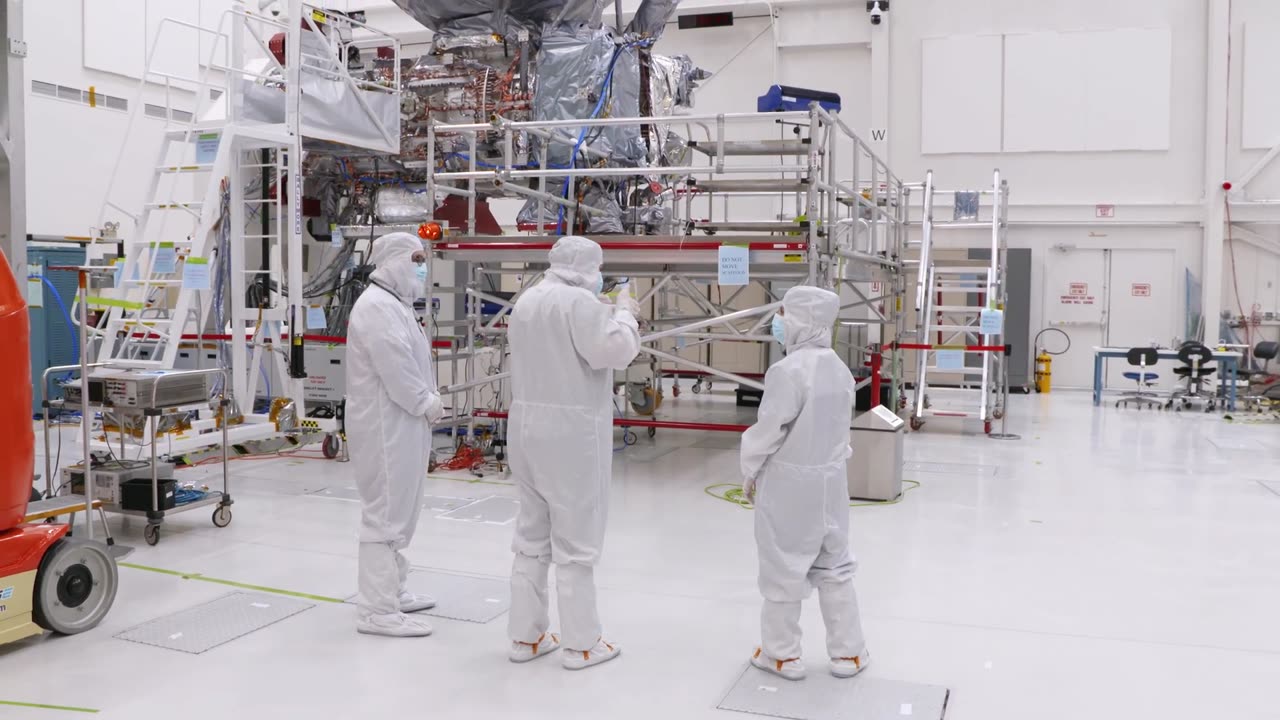Premium Only Content

Spacecraft Makers: Europa Clipper's Instrument Integration
#spacecraft #europaclippers #integration #spaceship #nasa #galaxies #spacerocket #rocket #aircraft #solarsystem #planets #wolfchamp
Spacecraft Makers: Europa Clipper's Instrument Integration
Hardware for NASA’s Europa Clipper spacecraft was developed at various institutions and facilities across the U.S. and Europe, including NASA's Jet Propulsion Laboratory. That work included the science instruments and other spacecraft components, such as the propulsion module, radio frequency module, solar arrays, electronics vault, and more.
During the assembly, test, and launch operations phase of the mission, engineers put together the spacecraft, test its various components, and prepare it for its launch and journey to Jupiter’s ice-encrusted moon Europa.
In this episode of the Spacecraft Makers video series, spacecraft assembly, test, and launch operations mechanical engineer Steve Barajas and science systems engineer Jenny Kampmeier provide a behind-the-scenes look at the nearly completed spacecraft in the High Bay 1 clean room at JPL.
The propulsion module for the spacecraft was built by the Johns Hopkins Applied Physics Laboratory (APL) in Laurel, Maryland, with help from NASA’s Goddard Space Flight Center in Greenbelt, Maryland, and JPL.
The science instruments were developed by APL, the School of Earth and Space Exploration at Arizona State University, Southwest Research Institute in San Antonio, JPL, UCLA, University of Michigan, University of Texas at Austin, and the Laboratory for Atmospheric and Space Physics at the University of Colorado Boulder.
Spacecraft Makers is a video series that takes audiences behind the scenes to learn more about how space missions, like Europa Clipper, come together. Europa Clipper will explore this icy moon of Jupiter to see if there are conditions suitable for life. The spacecraft needs to be hardy enough to survive a 1.6 billion-mile, six-year journey to Jupiter – and sophisticated enough to perform a detailed science investigation of Europa once it arrives at the Jupiter system in 2030.
Europa Clipper is expected to launch in October 2024 from Kennedy Space Center in Florida.
Spacecraft Makers: Europa Clipper's Instrument Integration
Hardware for NASA’s Europa Clipper spacecraft was developed at various institutions and facilities across the U.S. and Europe, including NASA's Jet Propulsion Laboratory. That work included the science instruments and other spacecraft components, such as the propulsion module, radio frequency module, solar arrays, electronics vault, and more.
During the assembly, test, and launch operations phase of the mission, engineers put together the spacecraft, test its various components, and prepare it for its launch and journey to Jupiter’s ice-encrusted moon Europa.
In this episode of the Spacecraft Makers video series, spacecraft assembly, test, and launch operations mechanical engineer Steve Barajas and science systems engineer Jenny Kampmeier provide a behind-the-scenes look at the nearly completed spacecraft in the High Bay 1 clean room at JPL.
The propulsion module for the spacecraft was built by the Johns Hopkins Applied Physics Laboratory (APL) in Laurel, Maryland, with help from NASA’s Goddard Space Flight Center in Greenbelt, Maryland, and JPL.
The science instruments were developed by APL, the School of Earth and Space Exploration at Arizona State University, Southwest Research Institute in San Antonio, JPL, UCLA, University of Michigan, University of Texas at Austin, and the Laboratory for Atmospheric and Space Physics at the University of Colorado Boulder.
Spacecraft Makers is a video series that takes audiences behind the scenes to learn more about how space missions, like Europa Clipper, come together. Europa Clipper will explore this icy moon of Jupiter to see if there are conditions suitable for life. The spacecraft needs to be hardy enough to survive a 1.6 billion-mile, six-year journey to Jupiter – and sophisticated enough to perform a detailed science investigation of Europa once it arrives at the Jupiter system in 2030.
Europa Clipper is expected to launch in October 2024 from Kennedy Space Center in Florida.
Spacecraft Makers: Europa Clipper's Instrument Integration
Hardware for NASA’s Europa Clipper spacecraft was developed at various institutions and facilities across the U.S. and Europe, including NASA's Jet Propulsion Laboratory. That work included the science instruments and other spacecraft components, such as the propulsion module, radio frequency module, solar arrays, electronics vault, and more.
During the assembly, test, and launch operations phase of the mission, engineers put together the spacecraft, test its various components, and prepare it for its launch and journey to Jupiter’s ice-encrusted moon Europa.
In this episode of the Spacecraft Makers video series, spacecraft assembly, test, and launch operations mechanical engineer Steve Barajas and science systems engineer Jenny Kampmeier provide a behind-the-scenes look at the nearly completed spacecraft in the High Bay 1 clean room at JPL.
The propulsion module for the spacecraft was built by the Johns Hopkins Applied Physics Laboratory (APL) in Laurel, Maryland, with help from NASA’s Goddard Space Flight Center in Greenbelt, Maryland, and JPL.
The science instruments were developed by APL, the School of Earth and Space Exploration at Arizona State University, Southwest Research Institute in San Antonio, JPL, UCLA, University of Michigan, University of Texas at Austin, and the Laboratory for Atmospheric and Space Physics at the University of Colorado Boulder.
Spacecraft Makers is a video series that takes audiences behind the scenes to learn more about how space missions, like Europa Clipper, come together. Europa Clipper will explore this icy moon of Jupiter to see if there are conditions suitable for life. The spacecraft needs to be hardy enough to survive a 1.6 billion-mile, six-year journey to Jupiter – and sophisticated enough to perform a detailed science investigation of Europa once it arrives at the Jupiter system in 2030.
Europa Clipper is expected to launch in October 2024 from Kennedy Space Center in Florida.
-
 LIVE
LIVE
Dr Disrespect
1 hour ago🔴LIVE - DR DISRESPECT - PUBG BLACK BUDGET - FIRST LOOK GAMEPLAY
8,830 watching -
 1:01:41
1:01:41
Steven Crowder
4 hours agoA Behind the Scenes Look into a MugClub Morning - How We Torture Gerald
90.6K51 -
 LIVE
LIVE
LFA TV
14 hours agoLIVE & BREAKING NEWS! | FRIDAY 12/12/25
4,458 watching -
 1:00:47
1:00:47
VINCE
4 hours agoKristi Noem's Hearing Turns Into Full-Blown Circus | Episode 187 - 12/12/25 VINCE
152K108 -
 1:36:34
1:36:34
Benny Johnson
2 hours agoFBI Finally Charges BLM Leader ARRESTED for Fraud, Money Laundering | Ilhan Ensnared…?
24.2K67 -
 28:30
28:30
Standpoint with Gabe Groisman
4 hours agoSenator John Fetterman on The Democratic Party, Socialism, Israel and More
2.11K2 -
 LIVE
LIVE
Film Threat
16 hours agoSILENT NIGHT, DEADLY NIGHT + DUST BUNNY + HAMNET + MORE | Film Threat Livecast
161 watching -
 LIVE
LIVE
The Shannon Joy Show
2 hours ago🔥SJ LIVE: The NYS Vaccine Mafia! The State Is Trying To Take A Dedicated Pediatricians Son.🔥
162 watching -
 LIVE
LIVE
The Mel K Show
21 hours agoMel K & Matt Ehret | The International Intelligence Deception Post WW2 | 12-12-25
577 watching -
 LIVE
LIVE
Daniel Davis Deep Dive
4 hours agoOne Way or Another Russia Will Get the Land /Patrick Henningsen & Lt Col Daniel Davis
94 watching